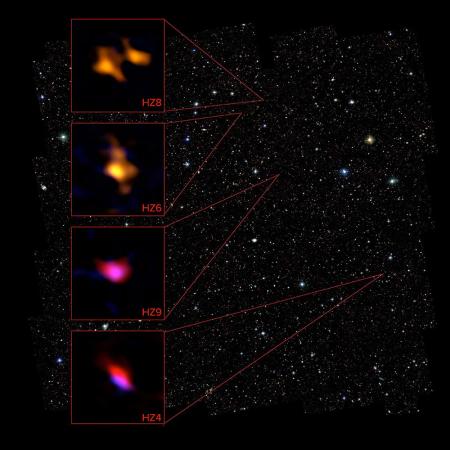It looks like you're using an Ad Blocker.
Please white-list or disable AboveTopSecret.com in your ad-blocking tool.
Thank you.
Some features of ATS will be disabled while you continue to use an ad-blocker.
7
share:

Using ALMA, astronomers surveyed an array of normal galaxies seen when the Universe was only 1 billion years old. They detected the glow of ionized carbon filling the space between the stars, indicating these galaxies were fully formed but chemically immature, when compared to similar galaxies a few billion years later. The ALMA data for four of these galaxies is show in relation to objects in the COSMOS field taken with the Hubble Space Telescope.
Credit: ALMA (NRAO/ESO/NAOJ), P. Capak; B. Saxton (NRAO/AUI/NSF), NASA/ESA Hubble
On its own, dust seems fairly unremarkable. However, by observing the clouds of gas and dust within a galaxy, astronomers can determine important information about the history of star formation and the evolution of galaxies. Now thanks to the unprecedented sensitivity of the telescope at the Atacama Large Millimeter Array (ALMA) in Chile, a Caltech-led team has been able to observe the dust contents of galaxies as seen just 1 billion years after the Big Bang—a time period known as redshift 5-6. These are the earliest average-sized galaxies to ever be directly observed and characterized in this way.
Young, faraway galaxies are often difficult to observe because they appear very dim from Earth. Previous observations of these young galaxies, which formed just 1 billion years after the Big Bang, were made with the Hubble Space Telescope and the W. M. Keck Observatory—both of which detect light in the near-infrared and visible bands of the electromagnetic spectrum. The color of these galaxies at these wavelengths can be used to make inferences about the dust—for example, galaxies that appear bluer in color tend to have less dust, while those that are red have more dust. However, other effects like the age of the stars and our distance from the galaxy can mimic the effects of dust, making it difficult to understand exactly what the color means.
The researchers began their observations by first analyzing these early galaxies with the Keck Observatory. Keck confirmed the distance from the galaxies as redshift greater than 5—verifying that the galaxies were at least as young as they previously had been thought to be. The researchers then observed the same galaxies using ALMA to detect light at the longer millimeter and submillimeter wavelengths of light. The ALMA readings provided a wealth of information that could not be seen with visible-light telescopes, including details about the dust and gas content of these very early galaxies.
Capak and his colleagues were able to use ALMA to—for the first time—directly view the dust and gas clouds of nine average-sized galaxies during this epoch. Specifically, they focused on a feature called the carbon II spectral line, which comes from carbon atoms in the gas around newly formed stars. The carbon line itself traces this gas, while the data collected around the carbon line traces a so-called continuum emission, which provides a measurement of the dust. The researchers knew that the carbon line was bright enough to be seen in mature, dust-filled nearby galaxies, so they reasoned that the line would be even brighter if there was indeed less dust in the young faraway galaxies.
Using the carbon line, their results confirmed what had previously been suggested by the data from Hubble and Keck: these older galaxies contained, on average, 12 times less dust than galaxies from 2 billion years later (at a redshift of approximately 4).
Well , this is interesting so if i understand this correctly they are able measure the age of a galaxy by the light and dust .
"In galaxies like our Milky Way or nearby Andromeda, all of the stars form in very dusty environments, so more than half of the light that is observed from young stars is absorbed by the dust," Capak says. "But in these faraway galaxies we observed with ALMA, less than 20 percent of the light is being absorbed. In the local universe, only very young galaxies and very odd ones look like that. So what we're showing is that the normal galaxy at these very high redshifts doesn't look like the normal galaxy today. Clearly there is something different going on.
Boom ,Science baby ! love it !
We are for the first time time able to see gas and stars forming from an early universe ,thus observing the cycles .
Read More Here
Thoughts
Kap
Nice read, thanks for posting. Cosmology is always interesting.
S&F!
S&F!
new topics
-
Planned Civil War In Britain May Be Triggered Soon
Social Issues and Civil Unrest: 21 minutes ago -
Claim: General Mark Milley Approved Heat and Sound Directed Energy Weapons During 2020 Riots
Whistle Blowers and Leaked Documents: 1 hours ago
7
